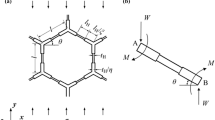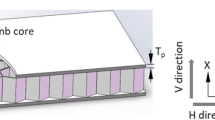Abstract
Monolithic copper honeycombs were fabricated by a plasticizing powder extruding-sintering technology. The effect of sintering conditions on volume shrinkage, apparent density, microstructure, mechanical properties and heat conductivity of copper honeycombs were studied. With increasing sintering temperature and time, the metal particles form sintering necks and gradually coalesces into grains, and volume shrinkage, apparent density and strength increase, and the optimum sintering parameters are 950 °C for 2 h. When sintering temperature rises from 800 to 1000 °C, the volume shrinkage ranges from 15 to 30%, and the apparent density ranges from 1.49 to 1.74 g/cm3. When sintering time increases from 1 to 2.5 h, the volume shrinkage ranges from 18 to 27%, and the apparent density ranges from 1.52 to 1.70 g/cm3. Under axial compression, the yield strength ranges from 7.2 to 20.4 MPa. Under radial compression, the yield strength ranges from 2.1 to 3.5 MPa. The longitudinal and transverse effective thermal conductivity of monolithic copper honeycomb was calculated by parallel and series models, respectively. The maximum longitudinal effective thermal conductivity of copper honeycomb is 50.26 W/(m K) and the maximum transverse effective thermal conductivity is 0.033 W/(m K), which indicates that the longitudinal heat transfer of copper honeycomb is much better than transverse. It can be designed as heat sinks by using the performance of longitudinal thermal conductivity of copper honeycombs.












Similar content being viewed by others
References
Z. Wang, Recent advances in novel metallic honeycomb structure. Compos. B 166, 731–741 (2019). https://doi.org/10.1016/j.compositesb.2019.02.011
Y. Zhou, X.Q. Zuo, J.H. Sun et al., Effects of sintering parameters on the structures of Fe–Cr–Al extruded honeycombs. Mat. Sci. Eng. A 457(1–2), 329–333 (2007). https://doi.org/10.1016/j.msea.2006.12.117
S. Wang, W. Li, Y. Tao et al., Investigation on the temperature dependent out-of-plane quasi-static compressive behavior of metallic honeycombs. Thin Wall Struct. 149, 106625 (2020). https://doi.org/10.1016/j.tws.2020.106625
R. Hussein, S. Anandan, M. Spratt et al., Effective elastic moduli of metal honeycombs manufactured using selective laser melting. Rapid Prototyp. J 26, 971–980 (2020). https://doi.org/10.1108/RPJ-12-2018-0311
F. Zhang, R. Ji, Y. Liu et al., A novel nickel-based honeycomb electrode with microtapered holes and abundant multivacancies for highly efficient overall water splitting. Appl. Catal. B 276, 119141 (2020). https://doi.org/10.1016/j.apcatb.2020.119141
X.C. Zhang, Y. Liu, B. Wang et al., Effects of defects on the in-plane dynamic crushing of metal honeycombs. Int. J. Mech. Sci. 52(10), 1290–1298 (2010). https://doi.org/10.1016/j.ijmecsci.2010.06.004
B. Han, K. Qin, B. Yu et al., Honeycomb–corrugation hybrid as a novel sandwich core for significantly enhanced compressive performance. Mater. Des. 93, 271–282 (2016). https://doi.org/10.1016/j.matdes.2015.12.158
T.N. Bitzer, Honeycomb Technology: Materials, Design, Manufacturing, Applications and Testing (Springer, Cham, 1997)
Z. Li, T. Yang, Q. Jin et al., Compressive behaviours of lotus-type porous copper fabricated by Gasar process. Procedia Eng. 31, 337–342 (2012). https://doi.org/10.1016/j.proeng.2012.01.1033
F. Agueniou, H. Vidal, J. de Dios López et al., 3D-printing of metallic honeycomb monoliths as a doorway to a new generation of catalytic devices: the Ni-based catalysts in methane dry reforming showcase. Catal. Commun. 148, 106181 (2021). https://doi.org/10.1016/j.catcom.2020.106181
B.C. Church, T.H. Sanders, R.F. Speyer et al., Interconnect thermal expansion matching to solid oxide fuel cells. J. Mater. Sci. 40(18), 4893–4898 (2005). https://doi.org/10.1007/s10853-005-3887-2
W.A. Cutler, L. He, A.R. Olszewski et al., Thermally conductive honeycombs for chemical reactors: U.S. Patent 6,881,703[P]. 2005-4-19
E. Tronconi, G. Groppi, T. Boger et al., Monolithic catalysts with ‘high conductivity’ honeycomb supports for gas/solid exothermic reactions: characterization of the heat-transfer properties[J]. Chem. Eng. Sci. 59(22–23), 4941–4949 (2004). https://doi.org/10.1016/j.ces.2004.07.018
J.L. Clark, J. Cochran, H. Thomas et al., in Metal Honeycomb from Oxide Paste: Maraging Steel and Super Invar Structure and Properties [C], ed. by A. Ghosh, T. Sanders, D. Claar. Processing and Properties of Lightweight Cellular Metals and Structures (TMS, Seattle, WA, 2002), pp. 137–146
L.C. Dial, T.H. Sanders, J.K. Cochran, The gas carburization of linear cellular alloys as a novel alloy development tool. Metall. Mater. Trans. A 43(4), 1303–1311 (2012). https://doi.org/10.1007/s11661-011-0973-8
A. Jakus, A. Fredenburg, N. Thadhani, High-strain-rate behavior of maraging steel linear cellular alloys: mechanical deformations. Mater. Sci. Eng. A 534, 452–458 (2012). https://doi.org/10.1016/j.msea.2011.11.093
L. Lu, Y. Shen, X. Chen et al., Ultrahigh strength and high electrical conductivity in copper. Science 304(5669), 422–426 (2004). https://doi.org/10.1126/science.1092905
T. Wen, J. Tian, T.J. Lu et al., Forced convection in metallic honeycomb structures. Int. J. Heat Mass Transf. 49(19–20), 3313–3324 (2006). https://doi.org/10.1016/j.ijheatmasstransfer.2006.03.024
G. Groppi, E. Tronconi, Honeycomb supports with high thermal conductivity for gas/solid chemical processes. Catal. Today 105(3–4), 297–304 (2005). https://doi.org/10.1016/j.cattod.2005.06.041
Y. Zhou, Study on Process, Property and Theory of Metal Honeycomb Prepared by Plasticizing Powder Extruding and Sintering. PhD Dissertation (Kunming University of Science and Technology, 2007)
Y. Gao, X. Gu, T. Liu, Sintering effect on the performance of tungsten-copper powder liner. J. Wuhan Univ. Technol. 27(6), 1133–1136 (2012). https://doi.org/10.1007/s11595-012-0616-y
K. Guo, M. Li, Q. Gong et al., Experimental investigation on steel foams fabricated by sintering-dissolution process. Mater. Manuf. Process. 31(12), 1597–1602 (2016). https://doi.org/10.1080/10426914.2015.1103852
A.M. Hayes, A. Wang, B.M. Dempsey et al., Mechanics of linear cellular alloys. Mech. Mater. 36(8), 691–713 (2004). https://doi.org/10.1016/j.mechmat.2003.06.001
Y. Zhou, Z.C. Hong, X.P. Ai et al., Manufacture, structure and properties of copper foams. Adv. Mater. Res. 652, 1163–1166 (2013). https://doi.org/10.4028/www.scientific.net/AMR.652-654.1163
S. Xie, J.R.G. Evans, High porosity copper foam. J. Mater. Sci. 39(18), 5877–5880 (2004). https://doi.org/10.1023/B:JMSC.0000040107.04387.b7
Y.Y. Zhao, T. Fung, L.P. Zhang et al., Lost carbonate sintering process for manufacturing metal foams. Scr. Mater. 52(4), 295–298 (2005). https://doi.org/10.1016/j.scriptamat.2004.10.012
M.T. Malachevsky, G. Bertolino, E. Oliber et al., Tomographic characterization of copper cellular bodies fabricated by a powder metallurgy route. Mater. Res. Express 6(5), 1–10 (2019). https://doi.org/10.1088/2053-1591/ab0310
C. Yang, L. Shouhang, Y. Tao et al., Research on the thermal conductivity of metals based on first principles. Acta Metall. Sin 57(3), 375–384 (2021). https://doi.org/10.11900/0412.1961.2020.00250
J. Banhart, Manufacture, characterisation and application of cellular metals and metal foams. Prog. Mater. Sci. 46(6), 559–632 (2001). https://doi.org/10.1016/S0079-6425(00)00002-5
W.J. Mantle, W.S. Chang, Effective thermal conductivity of sintered metal fibers. J. Thermophys. Heat Transf. 5(4), 545–549 (1991). https://doi.org/10.2514/3.299
L.S. Verma, A.K. Shrotriya, R. Singh et al., Prediction and measurement of effective thermal conductivity of three-phase systems. J. Phys. D 24(9), 1515–1526 (1991)
Acknowledgements
The authors would like to gratefully acknowledge the National Nature Science Foundation of China (Grant No. 51861020) for providing the financial support for this work. The authors would like to thank Yunnan Key Laboratory of New Material Producing and Processing for technical supports.
Author information
Authors and Affiliations
Corresponding author
Additional information
Publisher’s Note
Springer Nature remains neutral with regard to jurisdictional claims in published maps and institutional affiliations.
Rights and permissions
About this article
Cite this article
Zhang, G., Liang, J., Song, S. et al. Microstructure and properties of copper honeycombs prepared by powder extruding and sintering process. J Porous Mater 29, 1969–1979 (2022). https://doi.org/10.1007/s10934-022-01305-2
Accepted:
Published:
Issue Date:
DOI: https://doi.org/10.1007/s10934-022-01305-2




